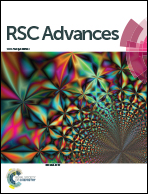Effect of curing on the mechanical and healing behaviour of a hybrid dual network: a time resolved evaluation
Abstract
In the present work we show the effect of the crosslinking degree on the mechanical and healing behaviour of a healable thermoset dual-network polymer. A hyphenated rheological test (i.e. simultaneous rheology and FTIR) was used to follow the effect of the curing process on the mechanical behaviour in relation to the underlying chemical reactions. The effect of curing on the bulk properties and the polymer interfacial healing was studied using gap closure kinetics and a fracture mechanical test. The increased crosslinking density at longer curing times led to a more temperature-stable polymer network with significantly higher mechanical properties (elastic modulus and strength at break). It was found that the damage closure kinetics decrease with the curing degree but the ultimate interfacial healing efficiency does not. The results here reported highlight the effect of the crosslinking density on the kinetics of damage closure with a low impact on the maximum interfacial healing efficiency as long as the amount of reversible bonds remains constant.


 Please wait while we load your content...
Please wait while we load your content...